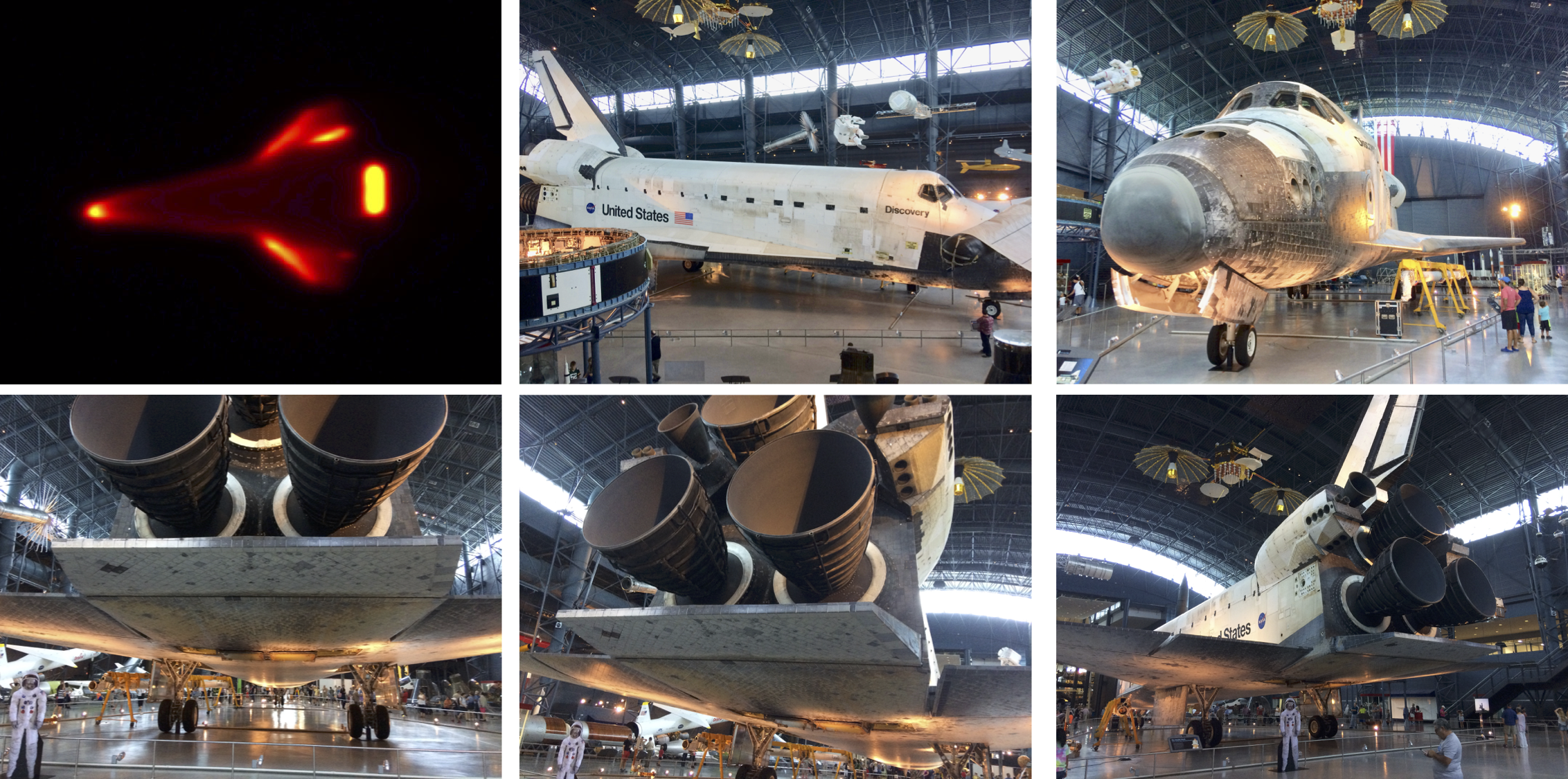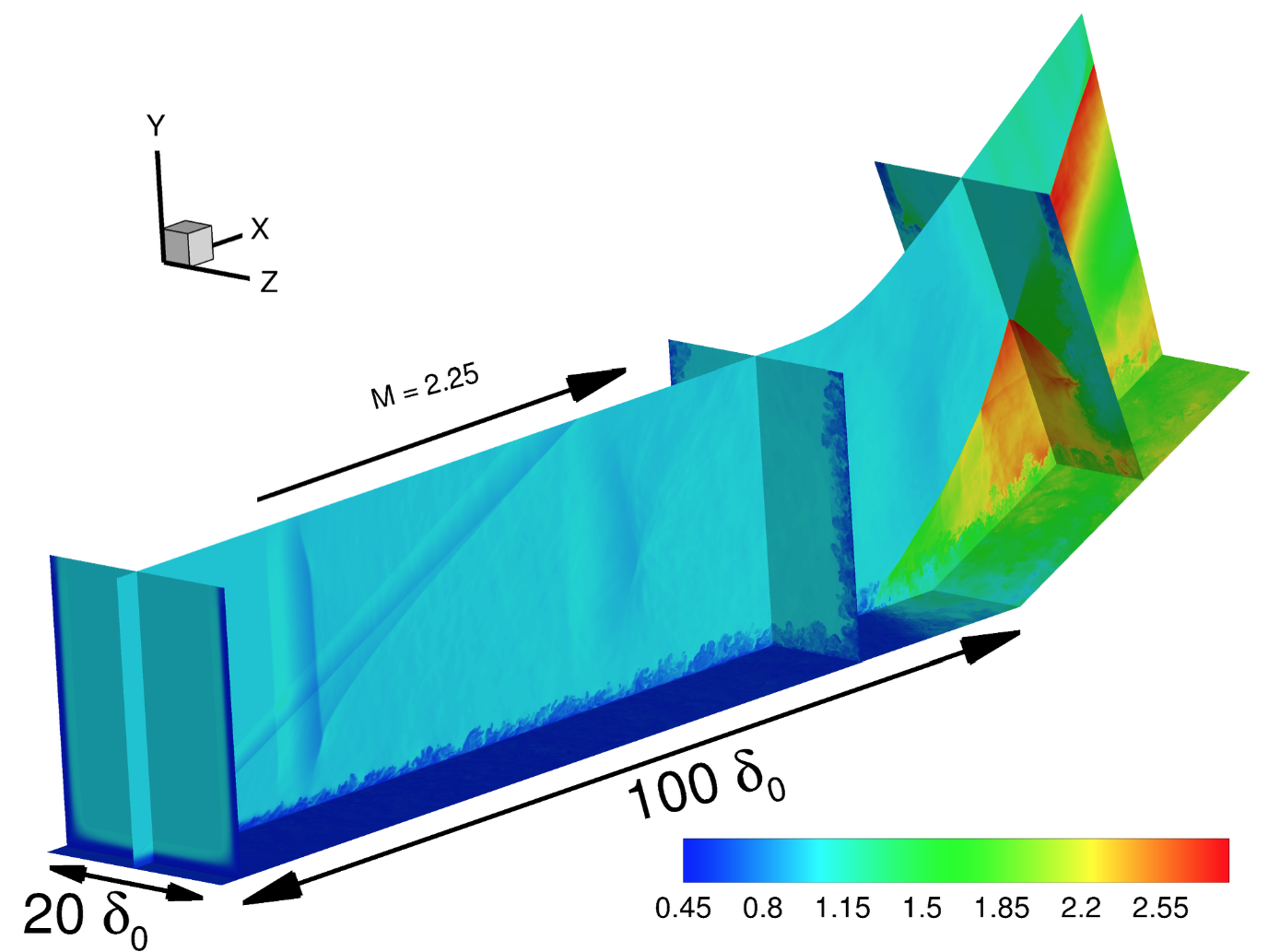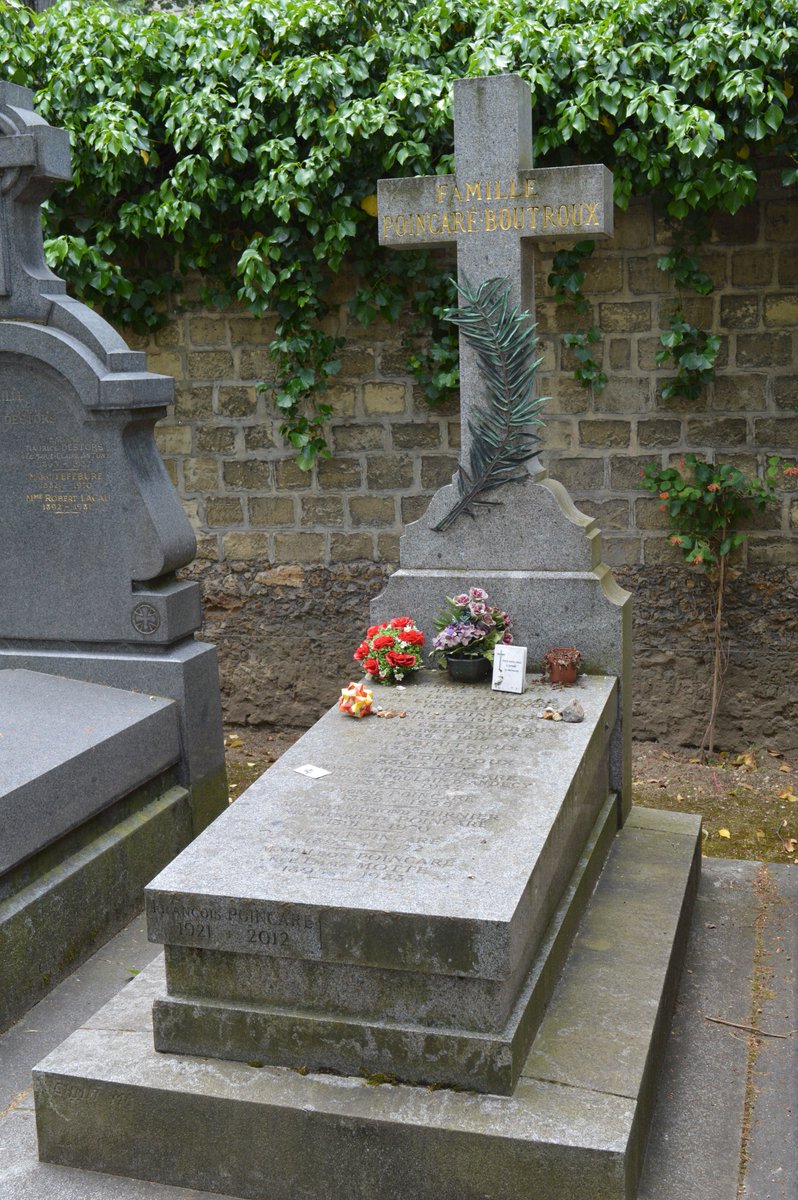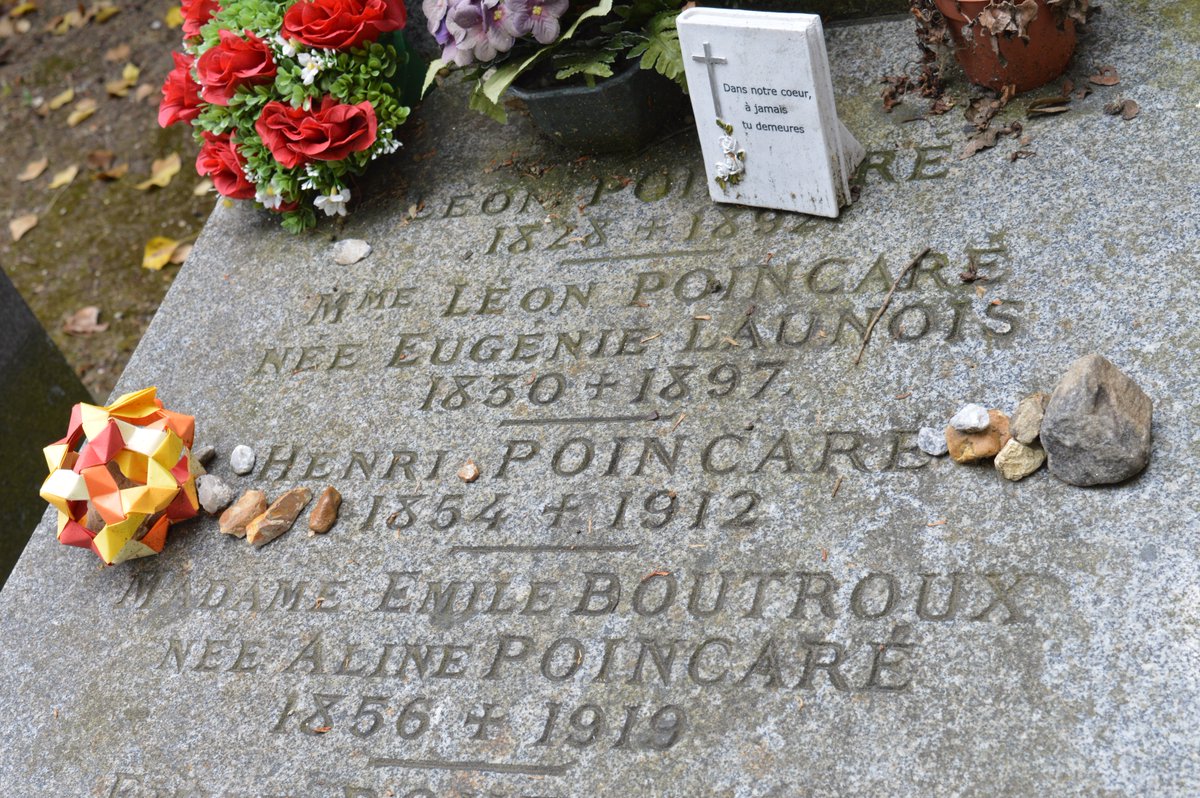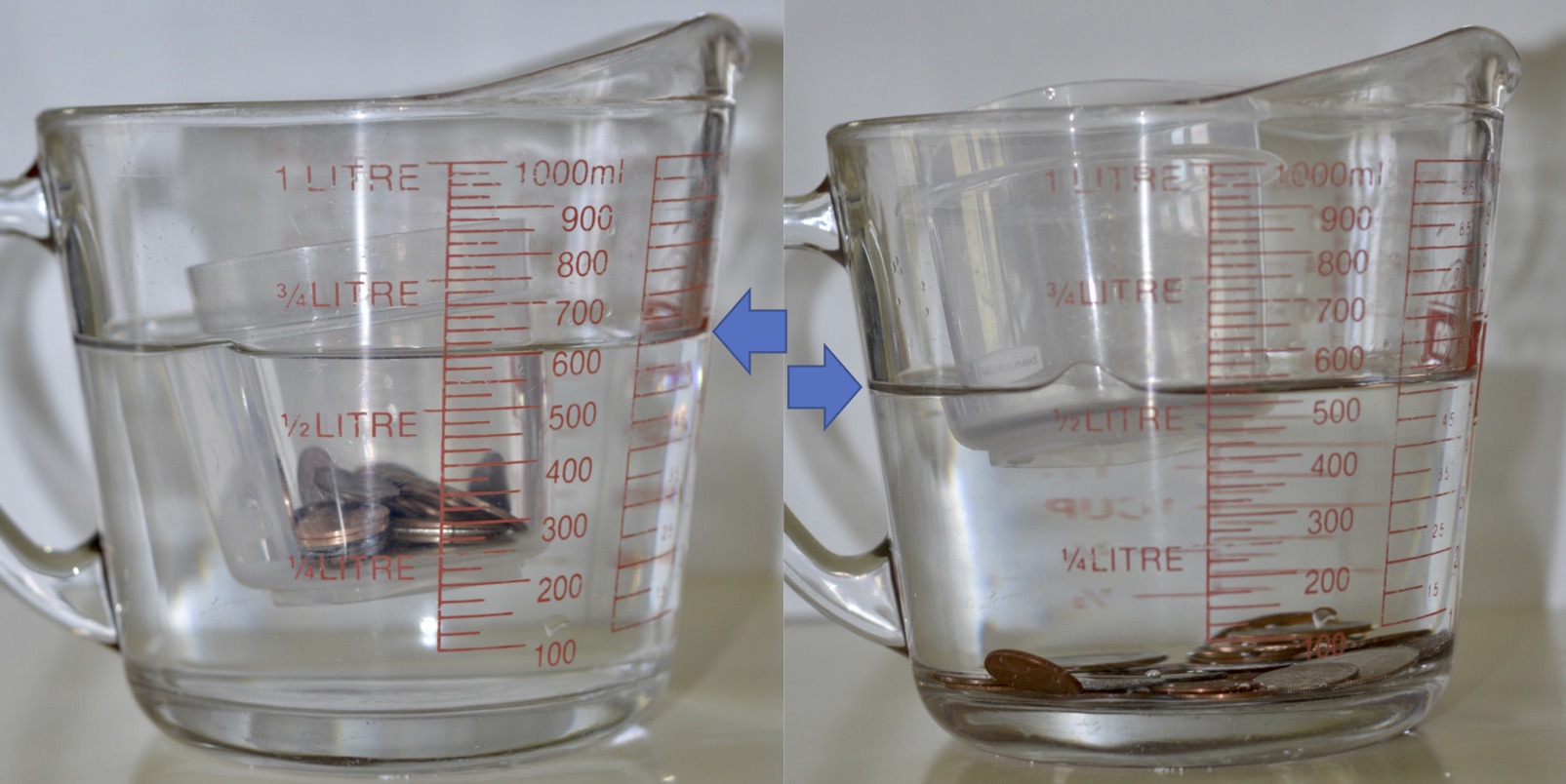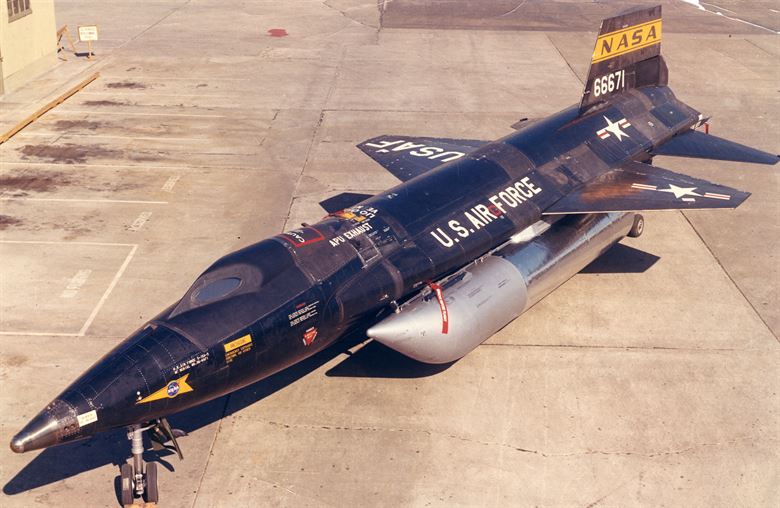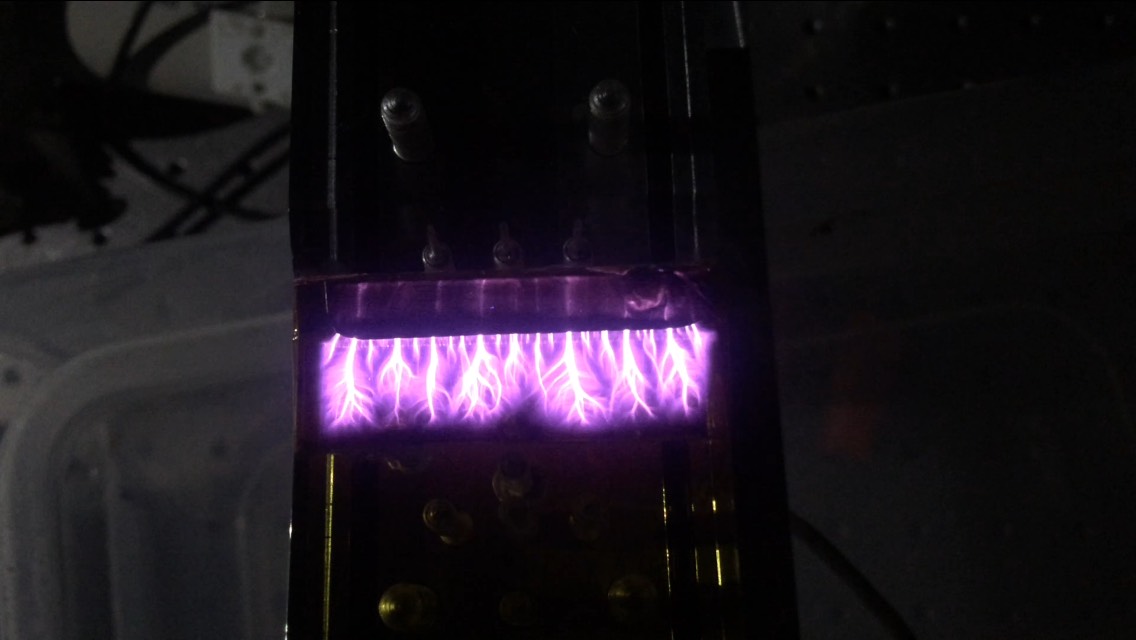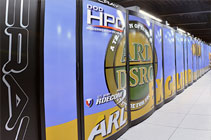Flow Resolution
News in 2017-2018 from Prof. Poggie's research group.
Heating Drives Design for High Mach Number Flight
On the top left is an infrared photograph of STS-128 (Discovery, September 2009) gliding in at Mach 13, obtained in NASA's HYTHIRM Project. The intense heating at the nose, wing leading edges, and body flap is very obvious. Other features in the photograph may be related to laminar-turbulent transition and gap heating. See the NASA AIAA Paper 2010-241 for details.
The remaining images (photos by J. Poggie) show Discovery on display at the Steven F. Udvar-Hazy Center, which is an annex of the Smithsonian National Air and Space Museum near Dulles International Airport. Notice the rounded nose and leading edges, the body flap, and the famous tiles that formed the thermal protection system (TPS). The form of the shuttle reflects design to survive the intense heating of high Mach number flight.
Sidewall Effects in Shock-Wave / Boundary-Layer Interaction
In a recent AIAA paper (AIAA 2018-4029), we examined the effect of sidewalls on a compression ramp flow for a case where the confinement effect was very strong (δ/w = 0.13).
Here are a couple of movies related to this work. They are quite high resolution: try playing them in full screen mode. In most browsers, right-clicking the movie will bring up a menu with this option.
The first movie is a view of the instantaneous magnitude of the skin friction with a view looking downstream along the ramp. Note the large-scale asymmetry that is often present in the instantaneous flow.
The second movie shows the flow from a different angle. The skin friction is shown on two boundaries, and the greyscale contours represent the instantaneous density field in a streamwise plane along the ramp. Intense unsteadiness is apparent in that plane.
Financial support for this work was provided by Purdue University, and by AFOSR Grant FA9550-17-1-0153, monitored by I. Leyva. This project was also supported by an award of computer time provided by the DoE INCITE program. This research used resources of the Argonne Leadership Computing Facility, which is a DoE Office of Science User Facility supported under Contract DE-AC02-06CH11357.
DoE INCITE Project
ASCR Discovery has released a nice publicity piece on our 2016-2017 DoE INCITE Project. We have a paper on this work at the 2018 AIAA AVIATION Conference: J. Poggie and K. M. Porter, "Numerical Simulation of Sidewall Influence on Supersonic Compression Ramp Interactions," AIAA Paper 2018-4029.
Henri Poincaré
I was in Paris last week, and I had a chance to visit the grave of Henri Poincaré (1854-1912) at the Montparnasse Cemetery. It is a pleasant location in the 14th Arrondissement.
Henri Poincaré is worth your attention for his wide-ranging scholarship and his balance between intellectual pursuits and engagement with the practical world. Poincaré made very significant contributions to philosophy, mathematics, physics, and engineering. He was also a civil servant in the French Ministry of Public Services, working on railways and mines.
Poincaré's investigations on relativity anticipated the work of Einstein, and many historians of science argue that Poincaré deserves more credit for establishing this field. In engineering, his work on chaos theory, the qualitative theory of differential equations (classification of trajectories near singular points in phase space), and celestial mechanics has been extremely influential.
His 1902 book for non-specialists, Science and Hypothesis (La Science et l'Hypothèse) remains relevant, and is well worth reading.
A Buoyancy Problem
I recently posed the following question to one of my classes: Imagine a barge with a load of steel in a lock in a canal. Say the load of steel falls off the barge into the water. Does the water level in the lock rise or fall? Why?
A skeptical student questioned whether anything at all would happen. (Everyone's a critic.) Here's a simple experiment that shows the result.
In the left picture, a handfull of coins are sitting in a plastic container floating in water. On the right, the container is empty and the coins are in the water.
If you want to check the numbers: To kitchen scale accuracy the coins were 93 g. Their volume was about 12 ml from water displacement in a smaller measuring cup. What do you expect the change in water level to be?
Graduate Students Attempt Daring Escape by Air
No luck, though. They had to go back to their research. From left to right: Akshay, Tugba, Ian, and Geoffrey.
W. A. Gustafson Teaching Award
Many thanks to the AAE juniors and seniors for the W. A. Gustafson Teaching Award.
Reusable Hypersonic Vehicle Structures Program
Our team is pleased to be working with Steve Schneider, the Air Force Research Laboratory, the University of Tennessee, and the University of Dayton Research Institute on new hypersonics project. Some details are here.
Cold Plasmas Preeminent Team
The new Cold Plasmas Preeminent Team website is live! Have a look here!
Considering graduate school?
Are you an undergraduate considering graduate school in engineering? You should be aware that there are a variety of graduate fellowships open to US citizens in engineering, and a few open to international students. You should consider applying; they give you a lot of freedom in the topics you work on and often a better stipend than an Research Assistantship (RA).
When I was in graduate school, I had an NSF fellowship early on, and later was in a program much like the SMART program that led to a job at the Air Force Research Laboratory. The NDSEG fellowship is also good, as is the Hertz fellowship.
Purdue Engineering maintains an excellent list of fellowships that are available, including ones open to international students. (If the link breaks, try here under Current Students, then Grad Student Resources.)
If you are undecided about graduate school, I recommend attending a few seminars that seem interesting. For example, the Purdue Women in High-Performance Computing organization holds 2-3 events per semester, and Purdue Research Computing sponsors workshops, coffee consultations, and seminars.
Hypersonic Flight
Ivett Leyva (AFOSR/RTA) has published a nice article in Physics Today on the scientific challenges posed by flight at hypersonic speeds.
Skills for Computational Physics
Currently, the most popular languages for high-performance computing are C, C++, and Fortran. Engineering students usually do some work with at least one of these languages, but when you get involved in a programming project, you may find yourself behind the curve. Here are some resources that may help if you need to write real code.
Some books:
- B. W. Kernighan and D. M. Ritchie, The C Programming Language, 2nd 3d., Prentice-Hall, 1988, ISBN-13: 978-0131103627
- B. Stroustrup, The C++ Programming Language, 4th ed., 2013, ISBN-13: 978-0321563842
- M. Metcalf, J. Reid, and M. Cohen, Modern Fortran Explained, Oxford U. Press, 2011, ISBN-13: 978-0199601424
Some web sites:
- Stack Overflow for a variety of programming questions
- MIT Open Courseware on general scientific programming
- A C++ Tutorial from Cambridge University
- A C++ Tutorial at cplusplus.com
- A C Tutorial at cprogramming.com
- A Fortran tutorial from Cambridge University
- Some Fortran tutorials from fortran.com
- Why Fortran is good for scientific programming
- A broad comparison of programming languages
On related note, you may find that the applied mathematics that you need is a distant memory. Here are a couple of books that may help:
- M. L. Boas, Mathematical Methods in the Physical Sciences, 3rd ed., J. Wiley, 2006, ISBN-13 978-0471198260
- E. Kreyszig, Advanced Engineering Mathematics, 8th ed., J. Wiley, 1999, ISBN-13 978-0471154969
Kreyszig includes almost everything that you need: ordinary differential equations, linear algebra, vector calculus, Fourier analysis, partial differential equations, complex analysis, numerical methods, optimization, and statistics. The book is nicely laid out, with a good balance of concepts and problem solving.
The textbook by Boas seems to be popular the physics community, and emphasizes problem solving. It covers most of the material in Keyszig's text, but also includes the calculus of variations and tensor analysis.
DoD HPCMP FY18 Frontier Award
Prof. Poggie leads a newly awarded Department of Defense High Performance Computing Modernization Program (DoD HPCMP) Frontier Project, collaborating with Dr. Roger L. Kimmel at the Air Force Research Laboratory and Prof. Lian Duan at Missouri University of Science and Technology. The project, entitled "Prediction of Hypersonic Laminar-Turbulent Transition through Direct Numerical Simulation," aims predict to acoustic noise and transition in conventional (noisy) hypersonic wind tunnels to make these facilities more useful for vehicle design. The project will last five years, and is also supported by a grant from the Office of Naval Research.
